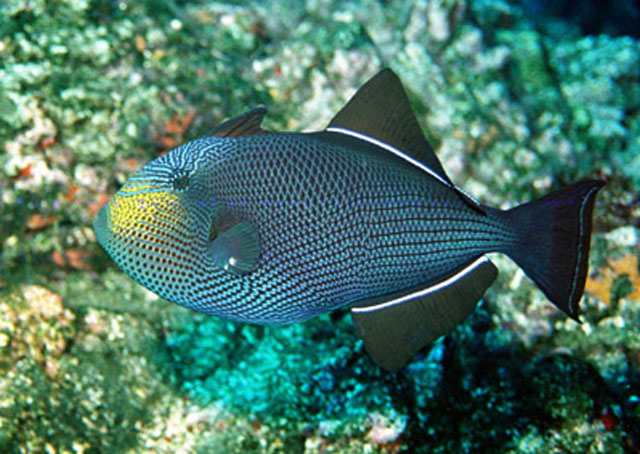| Balistidae (Triggerfishes) |
| 50 cm TL (male/unsexed) |
|
reef-associated; marine; depth range 0 - 75 m |
| Circumglobal. Uncommon in most areas but abundant around isolated oceanic islands (Ref. 9710). |
|
Dorsal spines (total): 3-3; Dorsal soft rays (total): 30-34; Anal spines: 0-0; Anal soft rays: 28-30. This species is distinguished by the following characters: a deep groove in front of eye; 20-25 head scale rows from corner of mouth to lower end of gill opening; 57-66 body scale rows from upper end of gill opening to caudal fin base; presence of prominent longitudinal ridges following scale rows of posterior body; slightly rounded to double emarginate caudal fin; a thin white bar neat posterior margin of the caudal fin; black spots on scales forming lines (Ref. 90102). |
| Inhabit clear seaward reefs. More common around oceanic islands (Ref. 9276). Found on inner and outer reef crests, usually near the slope or drop-off to deeper water, where in small but loose aggregations. Sometimes swim high above substrate feeding on zooplankton (Ref. 48637). May also be solitary (Ref. 90102). Benthopelagic (Ref. 58302). Diet consists primarily of calcareous algae and zooplankton (Ref. 1602); also feed on phytoplankton (Ref. 5213). At Fernando de Noronha Archipelago, southeast Atlantic, groups of about 100 individuals join groups of spinner dolphins to feed on feces and vomits of the cetaceans when they congregate in a shallow bay for rest and social interactions. The postures a dolphin adopts prior to defecating or vomiting are recognized, and the fish begin to converge to the dolphin shortly before the actual voiding. Offal feeding may be regarded as a simple behavioral shift from plankton feeding to drifting offal picking (Ref. 48727). Marketed fresh (Ref. 9770). Minimum depth reported taken from Ref. 128797. |
|
Least Concern (LC); Date assessed: 06 June 2011 Ref. (130435)
|
| harmless |
Source and more info: www.fishbase.org. For personal, classroom, and other internal use only. Not for publication.
